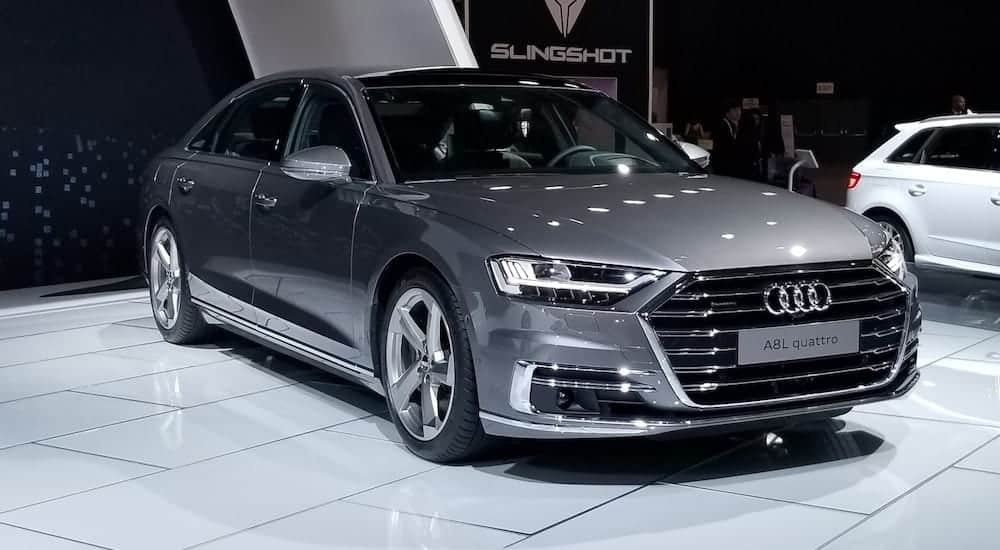While Audi may have counted themselves among the upmarket brands which declared an early absence from this year’s NAIAS in Detroit, they were on-hand in Las Vegas just a week earlier, attending the CES Technology conference.
So what technology was Audi on-hand to present? While one might assume that it has something to do with enhanced safety features, or perhaps be associated with their part in the race towards autonomous driving, you’d be wrong.
Audi’s appearance was largely focused on their introduction of ‘holoride’ a new VR technology which quickly asserts itself as a bit of a game-changer in the arena of automotive infotainment. Intended (at least initially) for pairing with the Audi e-tron, holoride is an in-car VR experience designed for the enjoyment of backseat drivers.
Partnering with Disney, the initial realization of this technology is experienced through a game called “Marvel’s Avengers: Rocket’s Rescue Run”, the narrative of which incorporates a number of Avengers: Endgame characters as part of an outer space mission. Viewable through VR glasses, the immersive experience is further enhanced by the actual movement of the vehicle. For example, if the vehicle takes a sharp right turn, that change in direction will be experienced by the player, as part of the VR game-play.
And while this is merely the first step in such infotainment technologies, holoride (of which Audi is part-owner) plans to create an even stronger bond between reality and game-play, incorporating everything from traffic stops and signage to shift in geographic locale. And while I’d never consider myself a gamer, or a fan of distractive technologies intended to silence juvenile passengers, it’s hard to argue the interesting nature of what holoride might represent.
A daily perusal of automotive news headlines reveals any number of reminders that we’re barreling down a tunnel towards the long-lamented ‘vehicle of tomorrow’. The introduction of holoride, albeit proprietary, will inevitably herald any number of similar technologies (or alternatively purposeful tools derived from them). To quote Mike Goslin, Vice-President of Disney Games and Interactive Experiences, “While this CES demo was developed purely in the spirit of exploration and experimentation, we are constantly evaluating emerging technologies to enhance our stories and experiences.”
Long story short, this is only the beginning.
Consider This
If you’re anything like me, you might be interested in what sort of assistive technologies could be derived from these advances in VR. But to use the correct nomenclature, it might be more appropriate to refer to it as AR (Augmented Reality). Consider the advent of the heads-up display, and it starts become easier to picture the possibilities.
Growing progressively more standardized with each model year, the heads up display is born of a noble intent: to minimize the distractions experienced by a driver. By projecting important data (normally found in the gauge cluster) onto the windshield, the driver can retain their focus on the road while monitoring vehicle speed, among other features.
It’s been long-predicted that smart windshields would be a part of the evolution of automotive technology. But the real-world introduction of AR technology linked to the motion of a car, combined with the current state of satellite-based navigational technologies, could do a lot to enhance the appeal of driving (in the eyes of certain drivers).
Whether your vehicle has a built-in navigation system, or you utilize the ‘maps’ feature on your smartphone, there is some appeal to its assistive nature. Whether it comes in visualizing the road up ahead, predicting the slowing of traffic, or communicating an upcoming turn that might otherwise be obstructed from sight.
Incorporation of VR technology is more than just goggle-fed gameplay. Incorporation of such technology into heads up displays could prove to be one of the most significant advances in advanced driver assistive systems. Eliminating the need for a secondary screen, navigational data could be mapped onto the transparent windshield enhancing the driver’s overall visibility of the road ahead of them.
As long as the display poses no real distraction, there’s very little downside to it being offered. Sure, there would be inevitable cost factors involved (especially in the case of a damaged windshield) but it could be a welcome evolution of existing technologies. Plus, it’s certainly a more functional application of the technology used in Snapchat filters.
But It’s Nothing New
For anyone who stays up to date on automotive technologies, the pursuit of this technology has been in the works for a while. And as with any technology worth pursuing, it is being developed simultaneously by any number of automakers.
Looking back to 2014, Jaguar Land Rover had introduced a 360-degree virtual windshield able to draw attention to collision risks, pedestrians traffic, while minimizing blind spots and even offer a ghost escort.
And in addition to being far from the most recent, JLR is far from the only player in the game. From fellow high-end automakers like Porsche to accessibly-priced innovators like Toyota, everyone wants in on AR windshields. It was even reported back in August that Apple had filed a number of international patents, detailing such technology.
Taking a Bite Out of Apple AR
A constant leader in innovation, there should be no surprise that Apple’s long-since had their hat in the ring. And while it’s unlikely that Apple would opt to become the exclusive partner of one automaker, it’s logical (with the advent of smartphone integration) that seamless connectivity with every vehicle is what Apple is aiming for.
That said, it’s reasonable to think that Apple’s approach is designed with (i) ease of implementation in mind (ii) connectivity with their own proprietary devices and services and (iii) base consistency with competitive projects.
And it’s the second of those three predictions that causes this writer some concern. While I tend to applaud the idea of creating assistive technology, there is some concern that the accessibility of FaceTime, iTunes and other proprietary programs might prove a distracting safety risk. One can only assume that safety measures will be taken into consideration, respectful of hands-free laws and minimizing any visual interfaces.
Is This the Final Form of Traditional Driving?
Just as maps gave way to GPS, we are on the precipice of traditional driving giving way to autonomous self-driving technologies. No longer the product of science fiction prediction, autonomous vehicles are already being road tested with many automakers racing to introduce street-legal offerings by 2025.
And while it might be unlikely for self-driving cars to become ‘the norm’ before another couple of decades, one can’t help but think the transition is somewhere on the not-too-distant horizon.
If true, it stands to reason that the string of automotive advancements currently being implemented, or developed, represent the last features that will be developed for pure, human-piloted automobiles. One can only expect an ever-evolving array of driver assistive features which will inevitably bridge the gap, easing us into autonomy. And it only makes sense that both VR and AR will play a roll in many of these advances.
Time will tell, but one thing’s for certain – and it’s something we find ourselves saying, a lot, as of late: the future is here.





